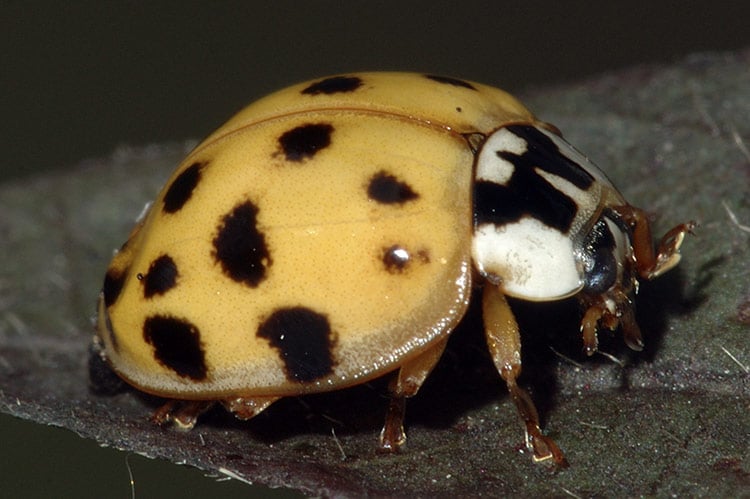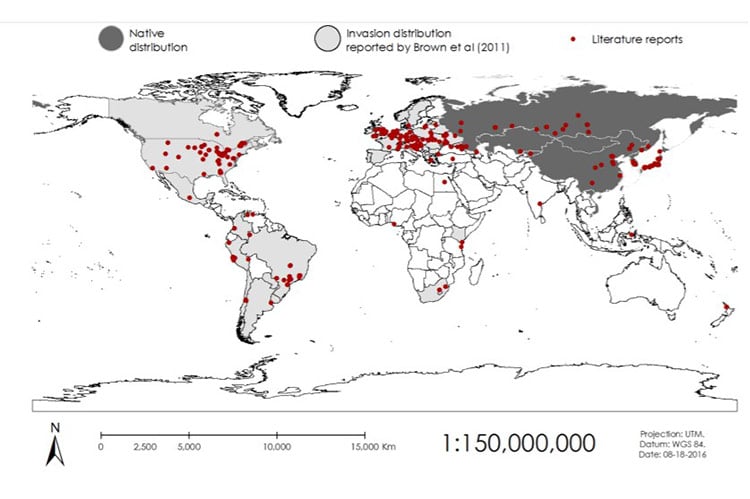New Zealand has undertaken an investigation into the presence of the Asian-native Harlequin ladybug (Harmonia axyridis), which first arrived in Auckland in 2016, and has found it already too widespread for a successful eradication campaign (1).
This ladybug is larger than native ladybirds and can prey on them, having the potential to reduce populations of beneficial insects in New Zealand vineyards.
Adult harlequin ladybugs are 5-8 mm long and 4-6.5 mm wide. They are highly variable in both colour and pattern. The hard shiny wing case colour may be orange, red or black (Figure 1). Orange and red forms may be patterned with 0 to 21 black spots or may display a grid-like black pattern. Black forms usually have two or four large orange or red spots. Other forms can have bars or stripes or be black with large patches of pale colour. The segment bearing the first set of legs is creamish-yellow with black markings; with these marking being in the form of four black spots, two curved lines, a black M-shaped mark or a solid black trapezoid (Figure 2)(2).

Geographic distribution of this pest is wide through natural dispersal and intentional introductions in Asia, Europe, North and South America, Middle East, South Africa, New Zealand (Figure 3) (3).

This begs some questions: is this pest already in Australia? Are our beneficial vineyard insects already under threat from this predator? Should we be on the look out for this pest? And are we finding this bug at the border?
The harlequin ladybird is a highly mobile generalist predator, with a long history of introductions as a biological control agent of scale insects (including mealybugs) and aphids around the world. It has been favoured for the biological control of aphids since the early 1900s because of its size, diverse dietary range, efficiency as a predator and wide niche colonisation ability. These very traits now contribute to the invasive nature of this beetle (2).
Importantly, H. axyridis has been recorded overseas as impacting the wine industry. It has a tendency to harbour inside grape bunches prior to harvest and can cause taint in resulting wines. It is also deemed a domestic nuisance pest, aggregating in buildings over winter.
In answer to some of the questions posed above: We have not formally investigated if this pest is already in Australia, but it is currently classified as exotic, despite past intercepts at the national border[1] and does pose a very real threat to our native ladybirds (5). While it’s on the radar internationally, we encourage growers on a local level to keep a watching brief on this ladybug and let us know what you find.
References
1. https://www.ruralnewsgroup.co.nz/wine-grower/wg-industry/harlequin-ladybird-update
2. https://www.cabi.org/isc/datasheet/26515#tosummaryOfInvasiveness
3. https://pdfs.semanticscholar.org/24d5/78e205fb1b64cf8745094c389b8e5b40af21.pdf
4. https://www.aph.gov.au/DocumentStore.ashx?id=b3b6aeb3-4c89-45db-bfa0-211f78eaca0a&subId=299612
5. https://invasives.org.au/wp-content/uploads/2019/06/Invasion-Watch_Harlequin-ladybird.pdf
[1] A published report indicates that between 2009 – 2014, 37 intercepts were recorded at the national border (4)